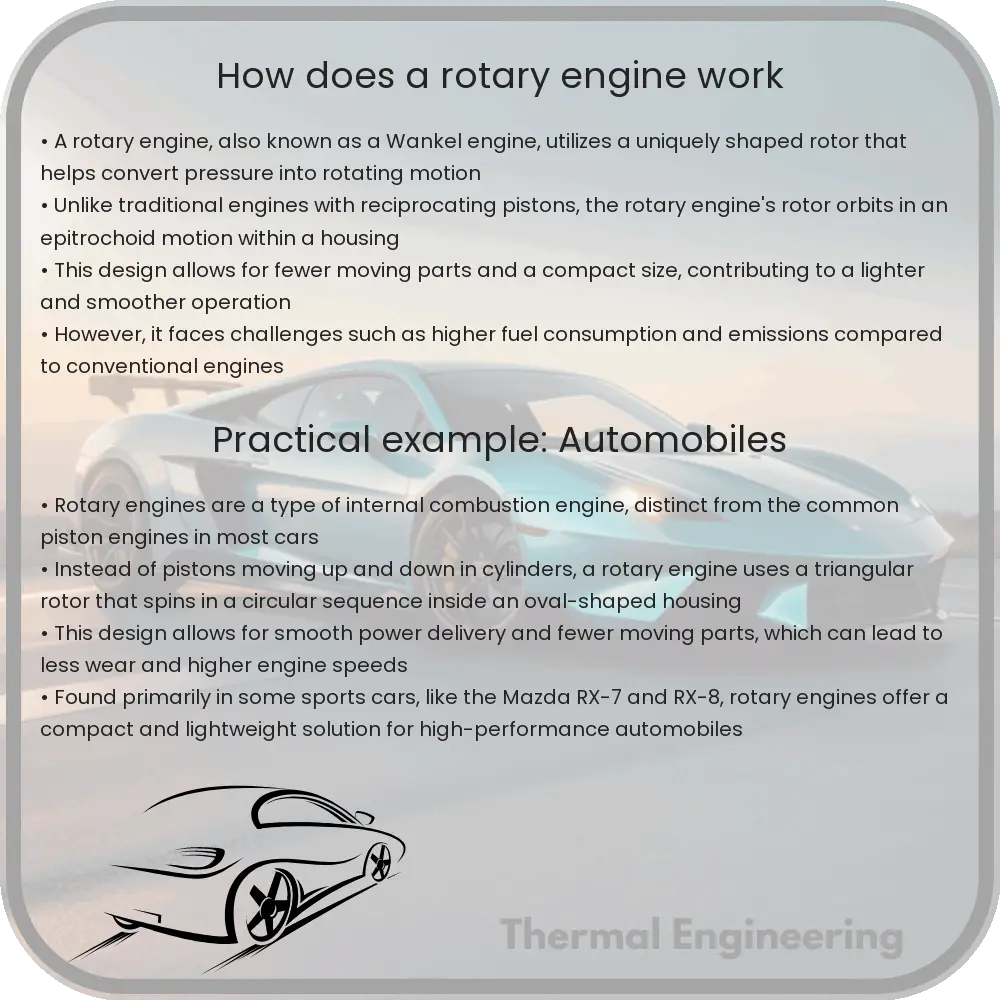A comprehensive guide to the rotary engine, exploring its unique design, operation, and how it differs from traditional piston engines.

Understanding the Rotary Engine
The rotary engine, also known as the Wankel engine, is a type of internal combustion engine that stands out for its unique design and mechanism of operation. Unlike the more common reciprocating piston engines, the rotary engine utilizes a radically different geometric approach to convert pressure into rotating motion. Here’s a deep dive into how rotary engines work and what makes them distinct.
Basic Working Principle
The heart of the rotary engine is the rotor, which rotates inside an epitrochoidal-shaped housing. The basic operation of a rotary engine involves three main processes: intake, compression, ignition, and exhaust. Each of these processes occurs in separate sections of the engine housing as the rotor rotates. Unlike piston engines which use the linear motion of pistons, the rotary engine uses the eccentric rotation of the rotor.
Components of the Rotary Engine
- Rotor: The triangular-shaped rotor replaces the conventional pistons. It rotates around an eccentric shaft and has three convex faces, each serving as a combustion chamber.
- Housing: The epitrochoidal or oval-like shape of the housing is designed to maintain contact with the rotor’s faces throughout each rotation cycle. To picture this shape, imagine a rounded triangle with sides that bulge outward.
- Intake and exhaust ports: These are located on the engine housing. The intake port allows the air-fuel mixture into the engine, and the exhaust port lets out the combustion gases.
- Spark plugs: Typically, there are two spark plugs per rotor, which are vital for igniting the air-fuel mixture in the combustion chambers.
Operation Cycle of a Rotary Engine
- Intake: As the rotor moves past the intake port, a mixture of air and fuel enters the combustion chamber formed between one face of the rotor and the housing.
- Compression: As the rotor continues to turn, the volume of the chamber decreases, compressing the air-fuel mixture. This movement brings the apex of the rotor closer to the spark plugs.
- Ignition: Once the air-fuel mixture is sufficiently compressed, the spark plugs ignite it, causing combustion. The force of combustion pushes the rotor, causing it to turn and produce power.
- Exhaust: As the rotor continues to rotate, the exhaust gases are pushed out of the chamber through the exhaust port when it aligns with it.
Advantages and Disadvantages of Rotary Engines
Rotary engines are admired for several advantages:
- Smooth Operation: Their design allows for fewer moving parts, which generally results in smoother operation compared to piston engines.
- Compact Size: They tend to be smaller and lighter than traditional engines with equivalent power outputs.
- High Power-to-Weight Ratio: Rotary engines can deliver more power relative to their weight, a characteristic beneficial in sports cars and aircraft.
However, there are some disadvantages:
- Fuel Consumption: They tend to have poorer fuel efficiency and higher emissions compared to piston engines.
- Wear and Tear: The rotor and housing are subject to wear due to the high-speed contact, requiring more frequent maintenance.
Conclusion
The rotary engine, with its innovative design, offers a different approach to generating power in vehicles and other machinery. While it has not become as widespread as the piston engine, its unique advantages make it particularly valuable for specific applications where size, weight, and smooth operation are crucial. Understanding the mechanisms behind the rotary engine provides an impressive glimpse into the variety of solutions engineering can offer to everyday challenges.